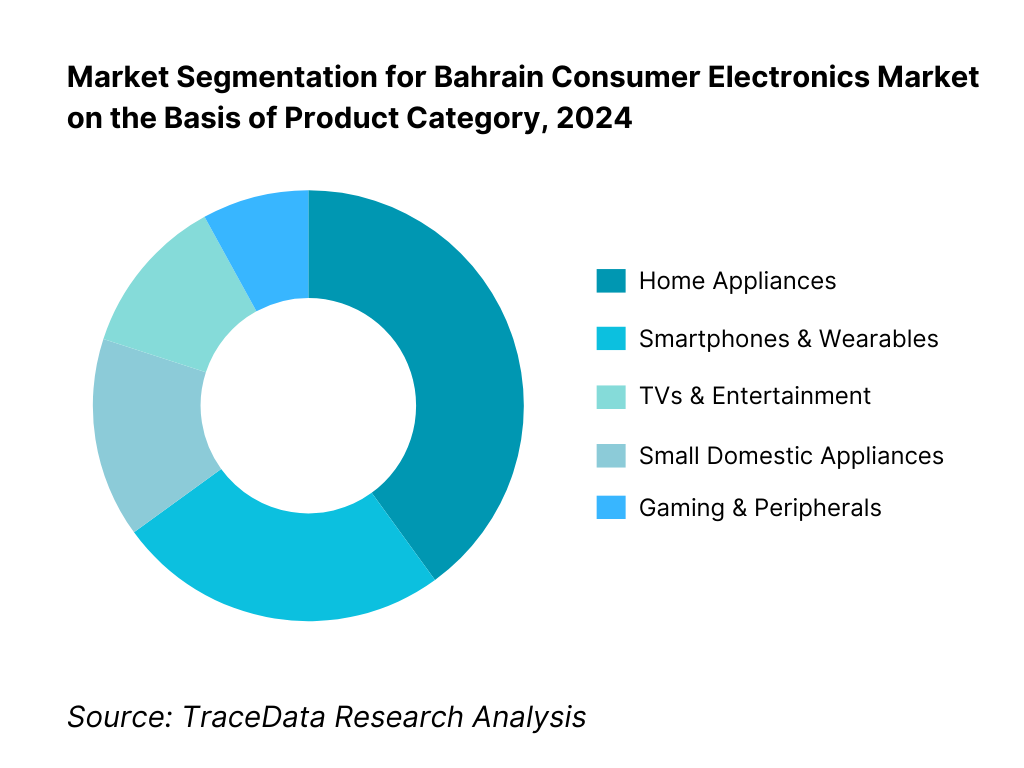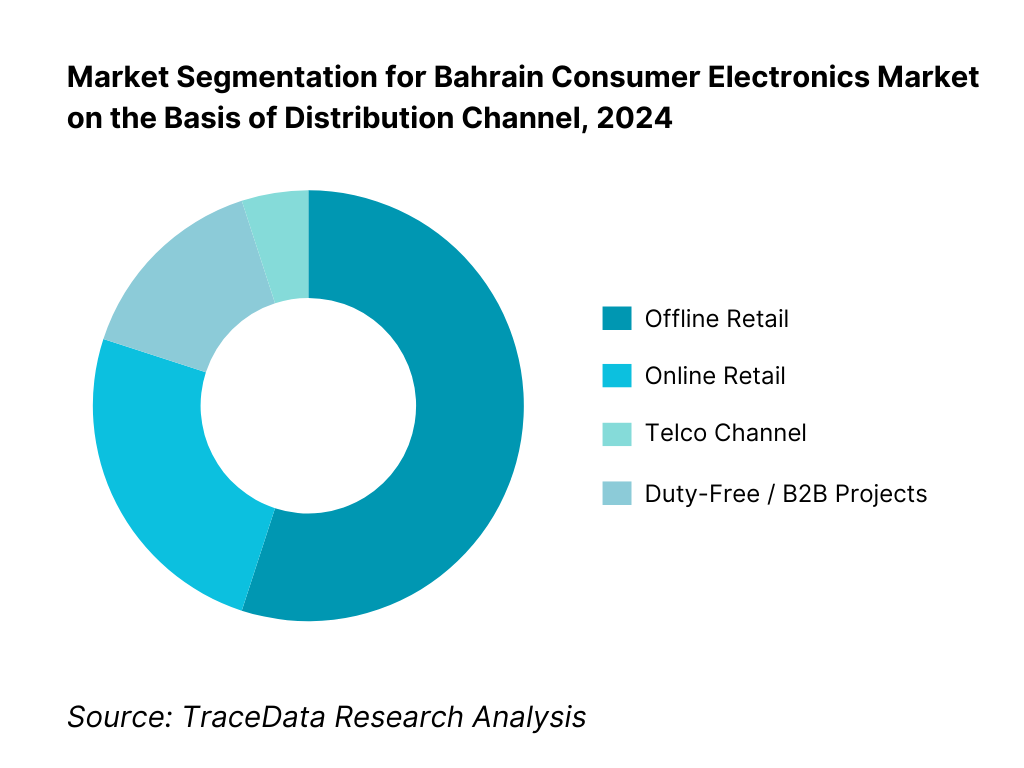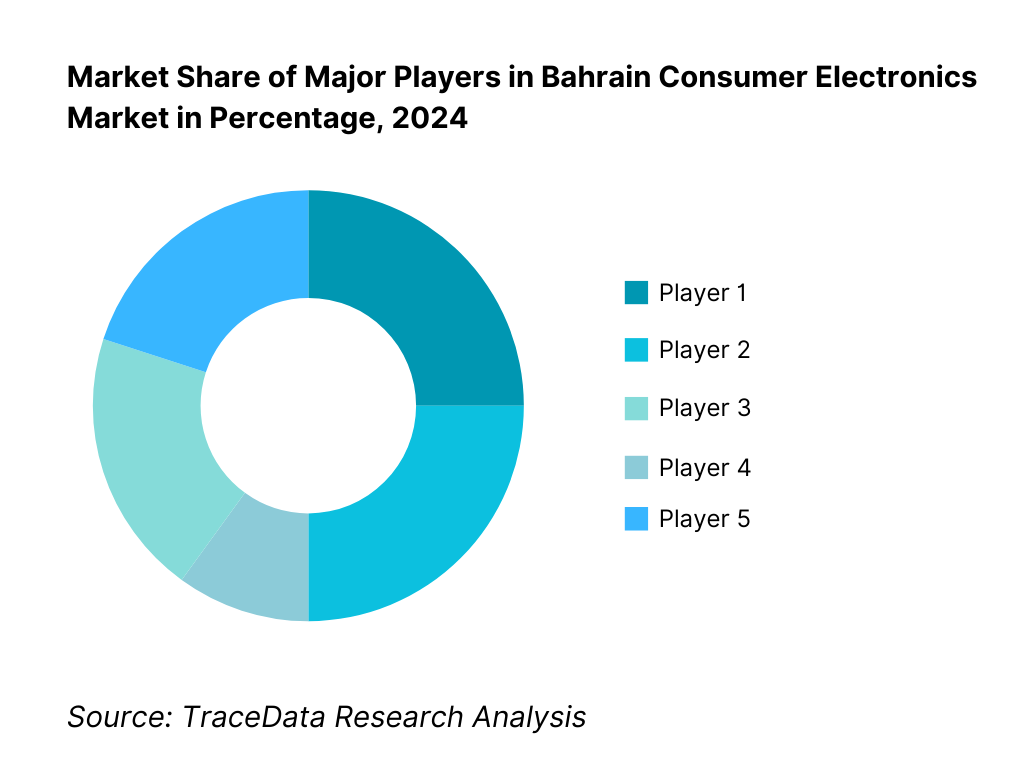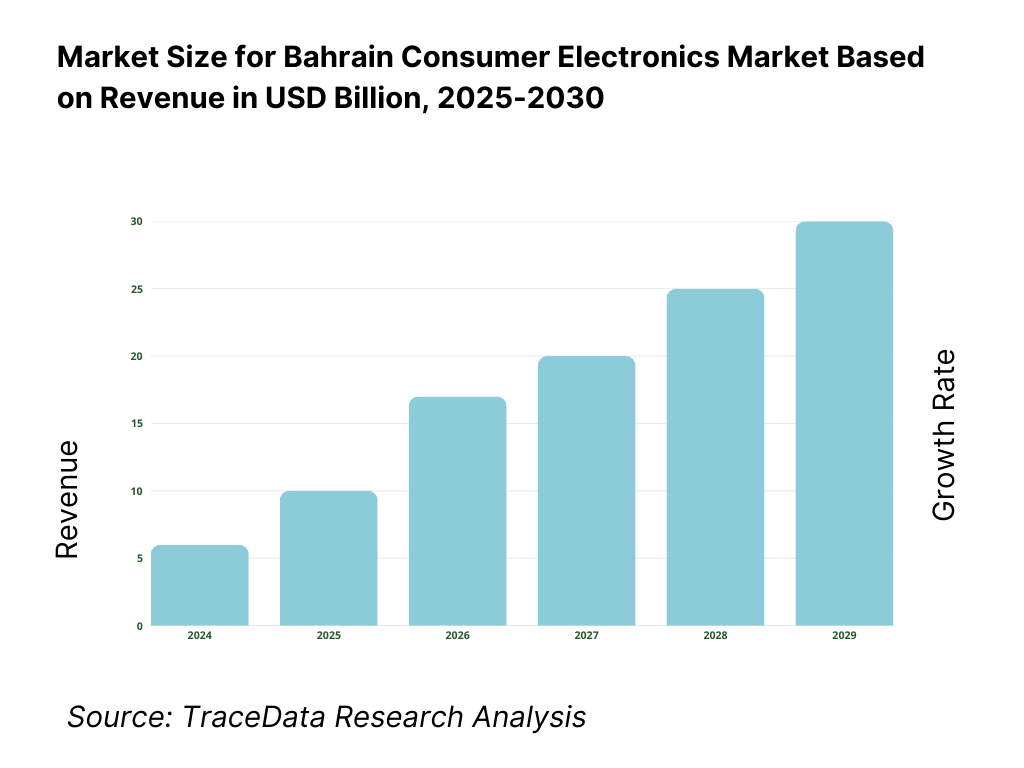Bahrain Consumer Electronics Market Outlook to 2030
By Product Category, By Price Tier, By Distribution Channel, By End-User, and By Region
- Product Code: TDR0237
- Region: Middle East
- Published on: August 2025
- Total Pages: 110
Introducing the World's FirstPay-Per-Section Market Reports
Why pay for the full report when you need just a part?
Start Building Your Report
Scroll down to see available sections
Report Summary
The report titled “Bahrain Consumer Electronics Market Outlook to 2030 – By Product Category, By Price Tier, By Distribution Channel, By End-User, and By Region” provides a comprehensive analysis of Bahrain’s consumer electronics landscape. The study covers the industry’s overview and genesis, overall market size in value terms, and granular segmentation and the four governorates. It evaluates trends and developments, the regulatory landscape, customer profiling and purchase journeys, issues and challenges, and the competitive landscape including competition scenario, cross-comparison dashboards, opportunities and bottlenecks, and detailed company profiles of major brands, distributors, retailers, and telco channels. The report concludes with future projections built on unit flows and value across products, channels, end-users, and regions, cause-and-effect linkages, and success case studies that highlight priority opportunities and execution cautions.
Bahrain Consumer Electronics Market Overview and Size
The Bahrain consumer electronics market is valued at USD 328 million in 2024, drawing from verified home-appliance valuations and relevant electronics literature. This valuation reflects strong fundamentals such as growing disposable incomes, rising urbanisation in major economic hubs like Manama, and increasing consumer demand for smart, energy-efficient electronics. The growth is further supported by robust infrastructure, high digital literacy, and government policies fostering modern retail—together ensuring sustained market momentum into 2024.
Leading the demand are metropolitan and affluent regions, notably the Northern Governorate (including Manama and Muharraq). Their dominance stems from higher per‑capita income, denser retail ecosystems, and early adoption of smart electronics. Additionally, Southern Governorate has emerged as a strong growth area, propelled by expanding middle-income households, new residential developments, and increasing sensitivity to energy-efficient products.

What Factors are Leading to the Growth of the Bahrain Consumer Electronics Market:
Ubiquitous connectivity and 5G-ready telecom base: Bahrain’s consumer-electronics demand is underpinned by a dense, always-on connectivity layer: mobile subscriptions reached 2,561,680 while fixed lines totaled 210,572, providing the networks that drive upgrades of smartphones, routers, wearables, TVs and smart home devices. The country’s compact, urbanized population of 1,588,670 enables rapid device diffusion and short replacement cycles as operators bundle handsets and CPE with high-speed plans. This infrastructure effect compounds with rising data consumption and platform usage, steering households and SMEs toward higher-spec devices that can exploit advanced networks and services.
Healthy consumption base and large expatriate workforce: Household final consumption expenditure stood at USD 17,953.78 million, reflecting resilient spending on durables and digital lifestyles. This demand is reinforced by the scale of actively employed expatriates—616,122 work permits in Q4 and 626,528 in Q1—who typically outfit rental housing with TVs, air-conditioners, small appliances, phones and laptops, and refresh these during relocations or employer changes. Together with a total resident base of 1,588,670, these dynamics sustain steady flows through organized retail and e-commerce, and support after-sales ecosystems (warranty, repair, accessories).
Tourism-led electronics pull in retail, hospitality and travel: Inbound visitor flows supply a second revenue stream for electronics retailers and B2B channels (hotels, malls, venues). Bahrain recorded 12.4 million visitor arrivals, with official communications stating 14.9 million the following year, fueling sales of travel adapters, wearables, cameras and in-room technologies (smart TVs, digital signage, conference A/V). Major events and retail festivals intensify footfall, while duty-free and airport retail convert high-intent travelers. The scale of arrivals also drives institutional procurement cycles in hospitality and MICE facilities (displays, POS, back-office IT), anchoring multi-channel demand beyond resident consumers.
Which Industry Challenges Have Impacted the Growth of the Bahrain Consumer Electronics Market:
Compact consumer base and saturated subscription environment: The market’s ceiling is shaped by population size 1,588,670 and an already high density of active lines—mobile subscriptions number 2,561,680 versus a small resident base. This saturation constrains first-time device adoption and shifts growth to replacement, premiumization and accessory ecosystems. For OEMs and retailers, planning must optimize SKU depth and in-store space for faster-moving mid-premium tiers, while distributors must manage inventory tightly to avoid obsolescence. Limited geographic dispersion raises competitive intensity in key retail corridors, necessitating omnichannel strategies and loyalty programs over pure footprint expansion.
Import exposure under USD-pegged monetary conditions: Consumer electronics are overwhelmingly imported; total merchandise imports amounted to USD 15.354 billion, with “electrical machinery and equipment” (HS85) alone at USD 1.23 billion. Bahrain’s dinar is pegged at 0.376 BHD per USD and policy rates closely follow U.S. moves; the CBB listed a one-week deposit (key policy) rate of 5.25 during the year. Currency pegs and imported-goods dependence make distributor working-capital needs and channel financing highly sensitive to U.S. rate cycles and freight terms, elevating the importance of hedging, lean inventory turns and diversified sourcing to cushion external shocks.
Talent intensity and after-sales capacity under expatriate labor dynamics: Retail floors, installation crews, and service centers rely on expatriate workers. Government open data shows 616,122 active foreign work permits at the close of the year and 626,528 in the subsequent quarter; LMRA notes 631,763 permits by Q2. Workforce churn and sponsorship transitions can strain call-out SLAs and extended warranty servicing during peak seasons. For OEMs, partnering with authorized service providers and investing in technician upskilling (calibration, board-level repair, R-32 HVAC handling) is mandatory to maintain net promoter scores and reduce return rates, particularly for premium appliances and smart-home ecosystems.
What are the Regulations and Initiatives which have Governed the Market:
Gulf Conformity (G-Mark) for Low-Voltage Electrical Equipment: The GSO BD-142004-01 regulation mandates conformity for low-voltage electrical equipment placed on GCC markets, with obligations for manufacturers, importers and distributors (documentation retention 10 years, Arabic safety information, market surveillance). Designated product lists and conformity routes apply; many household devices fall within scope (e.g., fans, refrigerators, washing machines, toasters, hair appliances, heaters, microwaves—8 product families commonly referenced by notified bodies). The scheme enables free movement across GCC customs territories once compliant. Electronics brands must plan certification lead times alongside seasonal buying cycles to avoid port delays.
TRA device type-approval for radio/telecom equipment: All radio and telecom terminal equipment (smartphones, routers, wearables with radios, IoT) must secure TRA equipment approval before market entry; the authority maintains an online platform and regularly updates technical specifications (Feb 27 update noted). The telecom environment features 3 licensed mobile network operators—Batelco, stc and Zain—whose band plans and network features guide OEM SKU planning. Importers should synchronize IMEI/TA approvals with shipment schedules to pre-empt customs delays and align retail launches with operator bundles and firmware builds.
Indirect taxation and customs for electronics trade: Bahrain applies 10% VAT (in force from January 1, 2022), affecting retail pricing, invoicing and input-tax credits across electronics categories. Customs duty for most commodities is 5% under the GCC Common External Tariff, while the U.S.–Bahrain FTA grants duty-free access for many U.S.-origin goods—important for certain SKUs and accessories. Distributors must code HS lines precisely and capture origin to optimize landed costs and cash-flow timing.
Bahrain Consumer Electronics Market Segmentation
By Product Category: Home Appliances lead within this segmentation (e.g., refrigerators, washing machines, dishwashers, microwaves) owing to their essential role in households and rising demand for energy-efficient, smart appliances. Consumers prioritize appliance upgrades, driven by modern lifestyle needs and cost-saving benefits. This segment consistently commands high spending, especially in urban households transitioning to smart homes.

By Distribution Channel: Offline Retail maintains primacy due to consumer preference for in-person experiences, product trials, and immediate availability—especially for large, technical, or premium items. Bahraini shoppers continue to trust physical stores for personalized service and tactile verification, reinforced by strong store networks of brands like Sharaf DG, Lulu, Apple APRs, etc.

Competitive Landscape in Bahrain Consumer Electronics Market
The Bahrain consumer electronics market is relatively consolidated, with major international brands operating through authorized distributors and strong retail networks. These players enjoy high brand recognition, robust distribution, and after-sales service—factors critical in high-involvement purchases like electronics.
Name | Founding Year | Original Headquarters |
Samsung (Bin Hindi Informatics) | 1938 | Suwon, South Korea |
Apple (iMachines / iWorld) | 1976 | Cupertino, California, USA |
Huawei (Experience Store) | 1987 | Shenzhen, China |
Xiaomi (Authorized Mi Store) | 2010 | Beijing, China |
LG (AJM Kooheji Group) | 1958 | Seoul, South Korea |
Sony (Ashrafs W.L.L.) | 1946 | Tokyo, Japan |
Hisense (MEA operations) | 1969 | Qingdao, China |
TCL (via Master Tech) | 1981 | Huizhou, China |
Sharaf DG Bahrain | 2005 | Dubai, United Arab Emirates |
Lulu Hypermarket Bahrain | 2000 | Abu Dhabi, UAE |
Carrefour Bahrain | 1957 | Boulogne-Billancourt, France |
stc Bahrain (device retail) | 1999 | Riyadh, Saudi Arabia |
Batelco (Beyon Shop) | 1981 | Manama, Bahrain |
Ashrafs W.L.L. (multi-brand) | 1940s | Manama, Bahrain |
Alesayi Electronics | 1970s | Jeddah, Saudi Arabia |
Some of the Recent Competitor Trends and Key Information About Competitors Include:
Samsung (via Bin Hindi Informatics): Samsung has strengthened its premium positioning in Bahrain, with the launch of AI-powered QLED and OLED TVs in 2024. The company also emphasized its smart ecosystem strategy by bundling SmartThings integration with home appliances, appealing to households seeking connected living solutions.
Apple (iMachines / iWorld): Apple maintained its dominance in the premium smartphone and wearable segments with the rollout of the iPhone 15 and new Apple Watch models in 2024. The brand has enhanced its in-store retail experience in Bahrain through APR expansions, offering financing and trade-in programs to retain customer loyalty.
Huawei (Experience Store): Huawei has continued to expand its footprint in Bahrain with an emphasis on wearables and tablets. In 2024, the brand focused on HarmonyOS ecosystem integration and strengthened its presence through bundled offers with telecom operators, especially for 5G-enabled devices.
Xiaomi (Authorized Mi Store): Xiaomi recorded significant growth in 2024 by expanding its mid-range smartphone portfolio and smart TV sales in Bahrain. Its strategy to offer feature-rich products at affordable price points has made it especially popular among younger consumers and price-sensitive households.
LG (via AJM Kooheji Group): LG has capitalized on Bahrain’s demand for energy-efficient appliances by expanding its inverter air conditioner and smart appliance range in 2024. The company has also partnered with major hypermarkets to increase its reach and visibility in both urban and suburban regions.

What Lies Ahead for Bahrain Consumer Electronics Market?
The Bahrain consumer electronics market is expected to expand steadily over the coming years, supported by strong macroeconomic fundamentals, high household consumption expenditure, and robust digital infrastructure. Demand growth will be driven by the rising adoption of smart appliances, the integration of IoT devices into homes, and supportive government initiatives around energy efficiency and digital transformation. Increasing tourist arrivals and a young, tech-savvy population will also continue to create opportunities for global and regional brands.
Rise of Smart and Connected Living: The market will see accelerated adoption of smart appliances, smart TVs, and IoT-enabled devices as households demand seamless connectivity. Integration with Bahrain’s high broadband penetration and growing 5G network coverage will make connected living a central driver of product replacement cycles.
Energy-Efficient Appliances as a Priority: With regulatory bodies mandating energy-efficiency labelling for key appliances, demand will tilt strongly toward inverter air conditioners, energy-rated refrigerators, and eco-friendly washing machines. Consumers are expected to increasingly prioritize long-term cost savings and sustainability, creating opportunities for brands with efficient product lines.
Omnichannel Retail Expansion: Electronics retail in Bahrain will increasingly blend online convenience with offline experience. Retailers like Sharaf DG, Lulu, and Carrefour are enhancing omnichannel models with same-day delivery, click-and-collect, and BNPL financing. This hybrid shopping model will dominate the buying journey, supported by Bahrain’s high smartphone penetration.
Telecom-Led Device Bundling: Telecom operators such as stc and Batelco are expected to play a larger role in device sales by bundling smartphones, wearables, and IoT devices with data and 5G plans. This model is likely to accelerate premium device adoption, especially among younger consumers and expatriate households.
Leveraging AI, AR, and Personalization in Retail: The future of electronics shopping will be shaped by AI-driven personalization, AR/VR in-store experiences, and predictive analytics for inventory and promotions. These innovations will enhance consumer experience, improve purchase conversion, and enable better after-sales engagement.

Bahrain Consumer Electronics Market Segmentation
By Product Category
Smartphones & Wearables
Home Appliances (Refrigerators, Washing Machines, Air Conditioners)
Televisions & Home Entertainment
Computing & Peripherals (Laptops, Desktops, Tablets)
Small Domestic Appliances (Kitchen & Personal Care Devices)
By Distribution Channel
Offline Specialist Retail
Hypermarkets & General Stores
Telco Device Stores
E-commerce Platforms
Duty-Free & B2B Sales
By Price Tier
Entry-Level
Mid-Range
Premium
Ultra-Premium
Luxury/Exclusive
By End-User
Residential Consumers
SMEs & SOHO
Government & Institutional Buyers
Hospitality & Real Estate Projects
Corporate Procurement
By Region (Governorates of Bahrain)
Capital Governorate (Manama)
Muharraq Governorate
Northern Governorate
Southern Governorate
Other Urban/Rural Clusters
Players Mentioned in the Report:
Samsung (via Bin Hindi Informatics)
Apple (iMachines APR)
Apple (iWorld APR)
LG (via AJM Kooheji Group)
Sony (via Ashrafs)
Xiaomi (Authorized Mi Store)
Huawei (Experience Store)
Hisense (through regional partners)
TCL (Master Tech support)
Sharaf DG Bahrain
Lulu Hypermarket Bahrain
Carrefour Bahrain
stc Bahrain (device retail)
Batelco (Beyon) Shop
Ashrafs W.L.L. (multi-brand retail/distributor)
Key Target Audience
Consumer Electronics OEMs and Brand Enterprises
Retail Chains & Hypermarket Executives
Telcos and Device Channel Leaders (e.g., stc, Batelco)
Logistics & E-Commerce Platform Investors
Payment & BNPL Fintech Players
Investment & Venture Capitalist Firms
Government & Regulatory Bodies (e.g., TRA, EWA, Ministry of Industry & Commerce)
Real-Estate & Hospitality Procurement Heads
Time Period:
Historical Period: 2019-2024
Base Year: 2025
- Forecast Period: 2025-2030
Report Coverage
Choose individual sections to purchase. Mix and match as you like.
- -
- -
- $100
4.1 Delivery Model Analysis for Consumer Electronics-Offline Retail, Online/E-Commerce, Telco Bundled, Duty-Free & B2B Project Channels-[Margins, Preference, Strengths and Weaknesses]
4.2 Revenue Streams for Bahrain Consumer Electronics Market [Device Sales, Accessories, Installation, Extended Warranty, Trade-In, BNPL Fees]
4.3 Business Model Canvas for Consumer Electronics Market [OEMs, Distributors, Retailers, Telcos]
$2505.1 Exclusive Distribution vs Multi-Brand Distribution [Strengths/Weaknesses]
5.2 Investment Model in Consumer Electronics [Capex in Showrooms, E-Commerce Platforms, Warehousing, BNPL Tie-ups]
5.3 Comparative Analysis of Funnel Processes by Offline Retailers vs Telcos vs E-Commerce [Awareness †’ Purchase †’ Service Journey]
5.4 Consumer Electronics Spending Allocation by Household Income Bracket [High-Income, Mid-Income, Low-Income Segments]
$150- $100
- $200
8.1 Revenues (In BHD)
$3009.1 By Market Structure [Organized Retail, Grey Market, E-Commerce, Telcos]
9.2 By Product Category [Smartphones, TVs, Air Conditioners, Laptops/Tablets, White Goods, Wearables, Gaming Consoles, Small Domestic Appliances]
9.3 By Price Tier [Entry, Mid, Premium, Ultra-Premium]
9.4 By Channel Type [Specialist Retail, Hypermarkets, Telco Shops, Pure-Play Online, Duty-Free]
9.5 By End-User [Residential, SME/Corporate, Government Projects, Hospitality/Real-Estate]
9.6 By Smartness/Connectivity [Smart Devices vs Non-Smart Devices, 5G vs 4G Smartphones]
9.7 By Energy Efficiency [Star-Rated ACs and Appliances]
9.8 By Region [Capital, Muharraq, Northern, Southern Governorates]
$40010.1 Consumer Landscape and Cohort Analysis [Expats vs Nationals, Youth vs Family Buyers]
10.2 Purchase Decision-Making Process [Price vs Brand vs Features vs Financing]
10.3 Device Usage & ROI Analysis [Lifespan, Energy Cost, Repair Rates]
10.4 Gap Analysis Framework [Desired Features vs Available Supply]
$50011.1 Trends and Developments [Smart-Home, 5G Smartphones, E-Commerce Growth, BNPL Adoption]
11.2 Growth Drivers [Rising Disposable Income, Digital Lifestyles, Hospitality Expansion]
11.3 SWOT Analysis for Bahrain Consumer Electronics Market
11.4 Issues and Challenges [Grey Imports, Price Competition, Service Quality, VAT]
11.5 Government Regulations [TRA Device Approval, Energy-Efficiency Labelling, VAT, BNPL Licensing]
$20012.1 Market Size and Future Potential for Online CE Market
12.2 Business Model and Revenue Streams [Commission, Logistics, Ads, BNPL]
12.3 Delivery Models and Categories Offered [Mobiles, TVs, White Goods, Gaming]
12.4 Cross Comparison of Leading Online CE Retailers [Company Overview, Investment & Funding, Revenues, Traffic, Number of SKUs, Fees, Logistics Model]
$500- $250
- $150
15.1 Market Share of Key Players [Basis Revenues and Volume]
15.2 Benchmark of Key Competitors
15.3 Operating Model Analysis Framework [Retail-led vs Telco-led vs Online-led]
15.4 Gartner Magic Quadrant for Bahrain Consumer Electronics Retailers
15.5 Bowmans Strategic Clock for Competitive Advantage
$75016.1 Revenues (In BHD)
$30017.1 By Market Structure [Organized vs Grey vs Online vs Telco]
17.2 By Product Category [Smartphones, TVs, ACs, White Goods, etc.]
17.3 By Price Tier [Entry, Mid, Premium, Ultra-Premium]
17.4 By Channel Type [Specialist, Hypermarket, Telco, Online, Duty-Free]
17.5 By End-User [Residential, SME, Government, Hospitality]
17.6 By Smartness/Connectivity [Smart vs Non-Smart]
17.7 By Energy Efficiency [Star Ratings]
17.8 By Region [Capital, Muharraq, Northern, Southern]
$400- $250
- $250
Research Methodology
Step 1: Ecosystem Creation
The first phase involves mapping the complete ecosystem of the Bahrain Consumer Electronics Market, identifying both demand-side and supply-side entities. On the demand side, this includes households, expatriate consumers, SMEs, government institutions, and the hospitality sector. On the supply side, we map OEMs, distributors, organized retail chains, hypermarkets, telco device channels, e-commerce platforms, and after-sales service providers. Based on this comprehensive mapping, we shortlist 5–6 leading competitors in Bahrain—Samsung (via Bin Hindi), Apple (iMachines/iWorld), LG (AJM Kooheji), Sony (Ashrafs), Huawei, and Xiaomi—evaluated on financial disclosures, retail presence, and product portfolio. Data sourcing is carried out through government trade portals, import/export records, and proprietary databases to collate industry-level information.
Step 2: Desk Research
An exhaustive desk research exercise is conducted, referencing diverse secondary and proprietary databases. This includes reviewing Bahrain’s import trade data, telecommunications authority statistics, VAT and customs policy documents, and retail industry reports. The focus is on collating insights related to product volumes, distribution channel contributions, regulatory costs, and consumption drivers. At the company level, we gather data from press releases, annual reports, distributor announcements, and filings with regulatory bodies. This phase enables the construction of a foundational understanding of both the overall electronics market structure and the business models of the leading players operating within Bahrain.
Step 3: Primary Research
In the primary research phase, we conduct structured interviews with C-level executives, distribution heads, and category managers across leading retail chains, distributors, and OEMs active in Bahrain. Interviews are also extended to demand-side stakeholders, including procurement managers in the hospitality sector and representatives of major telecom operators (stc and Batelco) to understand bundled device dynamics. The objectives are threefold: validate statistical data gathered from secondary research, authenticate pricing and operational practices, and derive financial insights such as revenue contributions by product category and channel. Disguised client-based interviews are used selectively to verify distributor margins, inventory models, and warranty processes, ensuring data triangulation across sources.
Step 4: Sanity Check
Finally, a top-down and bottom-up modeling exercise is undertaken to validate the market size and segmentation framework. Top-down analysis leverages macroeconomic indicators such as Bahrain’s household consumption expenditure and import values for electronics categories, while bottom-up analysis aggregates category-level sales volumes, ASP estimates, and channel contributions derived from retail audits and interviews. This dual approach ensures alignment between national-level economic trends and company-level operational realities, providing a robust and validated view of the Bahrain Consumer Electronics Market.
FAQs
01 What is the potential for the Bahrain Consumer Electronics Market?
The Bahrain consumer electronics market shows robust potential, underpinned by high connectivity, a tech-savvy and urbanized population, and a concentrated retail ecosystem that accelerates product launches and replacements. Continuous investment in 5G and broadband, strong household consumption, and a sizeable expatriate base sustain demand across smartphones, large-screen TVs, energy-efficient air conditioners, and smart appliances. Hospitality, real estate, and corporate fit-outs add a steady B2B layer, while government emphasis on energy efficiency and digital services pushes households toward smart, connected, and inverter-based products—expanding both value and premium tiers.
02 Who are the Key Players in the Bahrain Consumer Electronics Market?
The market features a tight mix of global brands and powerful local channel partners. Leading OEMs and brand ecosystems include Samsung (via Bin Hindi Informatics), Apple (iMachines, iWorld), LG (AJM Kooheji Group), Sony (via Ashrafs), Huawei, Xiaomi, Hisense, and TCL. Multi-brand retailers and channel anchors such as Sharaf DG, LuLu Hypermarket, Carrefour Bahrain, Ashrafs W.L.L., and telco device channels—stc Bahrain and Batelco (Beyon) Shop—shape category visibility, financing options, and after-sales reach. Their combined strengths in merchandising, omnichannel logistics, and service coverage consolidate market influence.
03 What are the Growth Drivers for the Bahrain Consumer Electronics Market?
Growth is propelled by always-on connectivity and rising device sophistication, which encourage frequent upgrades and ecosystem purchases (phones + wearables + smart home). Energy-efficiency rules and consumer awareness are shifting demand toward inverter ACs and high-efficiency whitegoods, lifting average selling prices and installation services. Omnichannel retail—click-and-collect, same-day delivery, BNPL and trade-in—improves access to premium devices, while tourism, hospitality, and commercial developments sustain B2B demand for displays, pro-AV, and back-office IT. Together, these forces expand both household and institutional refresh cycles.
04 What are the Challenges in the Bahrain Consumer Electronics Market?
A compact population caps absolute unit volumes, pushing players to compete intensely on assortment, service, and promotions. Import dependence exposes working capital to shipping costs and interest-rate cycles; tight inventory control and hedging become critical in fast-moving categories. Grey/parallel imports and warranty leakage can pressure authorized pricing and after-sales economics, while skills gaps in installation and board-level repair risk longer turnaround times during peak seasons. Finally, quick technology cycles raise obsolescence risk, requiring disciplined S&OP, sell-out visibility, and coordinated launch calendars with global principals.